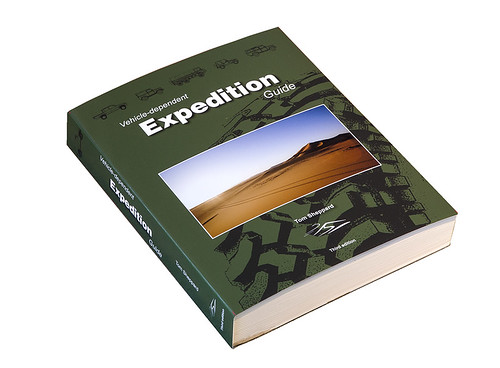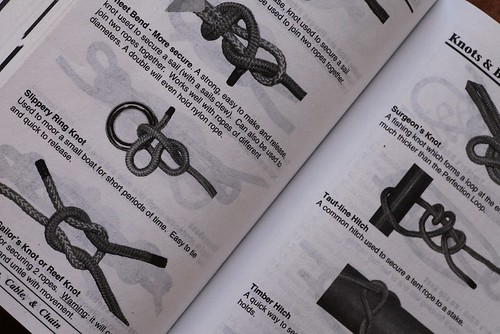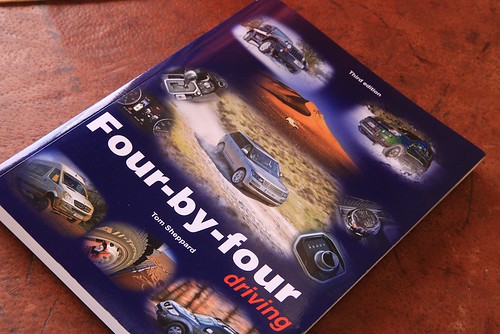
Overland Tech and Travel
Advice from the world's
most experienced overlanders
tests, reviews, opinion, and more
Need gift ideas for the Overlander in your life?
OVERLAND EXPO IS HERE TO HELP WITH A HANDPICKED LIST:
Threshold Provisions energy bar subscription (from $12/month)
Remember fruit of the month? Or, worse, fruitcake of the month? This is better. Every month your lucky recipient will receive a selection of four of Threshold Provisions’ delicious, all-natural energy bars (other options are available too—salmon jerky anyone?). Give the gift that keeps on giving energy.
Somewhere Else Tomorrow DVD ($19)
A beautifully shot story of one man’s journey, not only riding around the world, but making his way as he travels around the world. This film is guaranteed to inspire any rider considering a journey of this kind and might make him re-think how to achieve it.
OutdoorX4 subscription ($25)
Among several good overlanding magazines, OutdoorX4 is the one that most concentrates on simply getting out there and having a wonderful time. You won’t feel like you need some über expedition vehicle to participate. Now starting its second year, each issue gets better.
ADV Moto subscription ($29)
Find the latest industry news and product reviews for adventure motorcycles that will take you to on a weekend ride or around the world. Also indulge in stories from riders who have traveled off the beaten path.
Chaos in Harmony by Alison DeLapp ($49)
An inspirational, lavishly photographed account of Alison’s 16,000-mile solo motorcycle journey from the U.S. to the tip of South America. Aside from a short introduction to each country, Alison lets her images do the talking, and they have a lot to say. Worth of coffee table placement and frequent browsing.
Tsuga Large Catchall ($55)
While it’s not sexy enough to warrant giant comparison tests, a heavy-duty hold-all-cum shopping bag is one of the most useful items you can have on a long overlanding journey. Groceries, car parts, firewood—you name it, the stout 18-ounce vinyl of the Tsuga will handle it.
Moto-skiveez Adventure Skiveez ($59)
Long days in the saddle has your rear end begging you for another? Chances are you are wearing a pair of Adventure Skiveez. This innovative riding underwear has padding in all the right places for both on road and aggressive off road riding.
Equipt/National Luna clip-on 9-LED light ($64)
I have a hard-mount version of this light in the cargo area of my FJ40, and it’s superb. The clip-on version, with a 27-foot cord, is even more versatile. The low (62 lumen) setting will light a dining table; click to high (176 lumen) to light the entire dining area.
Mosko Moto 30L waterproof scout duffle ($69)
For the minimalist packer or small bike enthusiast, this duffle does the trick. Not only will it keep your items dry during all types of weather, it features an innovative strap system so it doubles as a backpack or shoulder bag off the bike.
Coyote Enterprises Automatic Tire Deflators ($80)
An improvement on the original excellent Staun deflators, the CE deflators will automatically deflate four tires at once, to a pressure you preset between 3 and 50 psi. Airing down is the best thing you can do to your vehicle to enhance traction, reduce trail erosion, and improve comfort.
Surefire 6PX Pro ($90)
I’ve been using Surefire lights for 20 years and have never had a failure—including one lost on a dirt road, run over for a week, then recovered. The 6PX Pro is a dual-output light (the only kind to get in my opinion) that combines a brilliant 320-lumen high beam with a camp-chore-oriented 15-lumen low beam that will last 45 hours on one set of lithium batteries. The only flashlight you need.
KinderRider Explorer motorcycle jacket ($100)
Kids deserve the same protection you do on a motorcycle. But they grow so fast it could get expensive buying new jackets every six months. The KinderRider Explorer features expandable sleeves to keep up for at least a year or two. Fully featured with vents, a thermal liner, and CE armor.
REV'IT! Sand Pro gloves ($119)
After spending a day gripping handlebars either on or off road, you know what comfortable hand protection is. REV’IT gets that with the Sand Pro gloves and offers a flexible and durable glove.
Canyon Coolers Outfitter 22 ($120)
You’ll never realize how inefficient cheap ice chests are until you try a good one. Whether you’re out for a day trip and don’t need the weight and bulk of a fridge, or just want an extra cooler in the cab, the Outfitter 22 will hold all you need—and keep it chilled with minimal ice—while not taking up a lot of room.
Anti-Gravity Batteries Microstart XP-1 ($159)
Simply put, this absurdly small lithium-ion battery/power supply is a miraculous product. We’ve jump-started a 460 cubic-inch V8 with one, and a Tacoma V6 three times in a row. We’ve even hooked three of them in series and produced a beautiful field weld (NOT recommended by the maker). Sure, you can recharge your iPhone/iPad etc. too, but its real value is insurance against ever getting stranded by a dead battery.
Mojoe Outfitter’s griddle ($195)
You know the trouble with most camp griddles. They’re too damn small. The Mojoe Outfitter’s grill solves that with over three square feet of cooking surface. It can be used on a standard Weber charcoal grill, above a propane heat source, or, on its screw-in legs, over an open fire. It’s 24 inches in diameter (and a full 1/4 inch thick) but stores flat—all 40 pounds worth of it. Titanium option?
American Camp Chair ($230)
For 20 years Roseann and I never found a camp chair that was as comfortable as our old South African tripolinas. The American Camp Chair—actually prototyped from one of those South African chairs—is superior in every way: better materials, more rigid setup, and more comfortable. The king is dead; long live the king.
Giant Loop Fandango Tank Bag PRO ($230)
Not your average tank bag. Made for the traveler in mind, the Fandango PRO has upgraded features for keeping your electronics organized and charged, as well as a concealed document pocket for easy access at the borders.
Baja Designs Squadron Pro LED auxiliary lights ($220 - $350)
Whether you want more light down the trail for a motorcycle or a four-wheel-drive vehicle, there is a Squadron Pro that will fit and hugely increase your margin of safety at night. Unlike earlier generations of LEDs, these cast an even, purple-haze-free carpet of brightness. Best of all, with a simple lens switch you can choose between fog, driving, and spot patterns.
Overland Experience package ($285 / $490)
Give an Overland Expo full-tuition education package, which includes access to hundreds of specialized classes taught by world-class instructors to help prepare for the trip of a lifetime Custom Overland Expo gift certificates for any amount are also available.
Fly fishing lessons with Hunter Banks ($375/day for two people)
Unlike some fly fishing schools, where you start on a lawn or pond, With Hunter Banks you’ll be wading in a beautiful North Carolina river and catching fish right from the start, with an expert guide coaching your technique. Prepare to be (you know this is coming) hooked. All equipment is included.
DeLorme inReach Explorer ($379)
More than a way to keep in contact with your loved ones, this satellite communicator now has built in navigation. In addition to sending and receiving messages, you can view your route using waypoints and share it with those at home.
My Camp Kitchen Outdoorsman ($579)
Nothing will make your camp feel like something out of an old Winchester ad than a proper chuck box, and the Outdoorsman is proper. The Baltic birch (or okoume) marine plywood construction is tough, but adds a nice organic touch, and the interior will hold all the vintage or modern cooking gear you own. Feeling handy? Buy it as a kit and save $175.
Tonto Trails Expedition Vehicle Rental (from $2,000)
Thinking about investing in a Sportsmobile or Four Wheel Camper? Or is your significant other unsure about this overlanding thing? Rent a fully equipped rig from Tonto Trails first, and explore some of the best of the western U.S. from their base in Durango, Colorado. Virtually everything you’ll need except food and clothing is included.
Bivouac Trailers M.O.A.B. Fort (from $5,695)
The base prices of some adventure trailers can leave you pondering whether to just buy a second four-wheel-drive vehicle to drive behind your main ride. Bivouac’s Fort offers a heavy-duty chassis and sturdy box but keeps the architecture simple to hold down the price. Of course a full range of options lets you accessorize as far as your taste and budget allow—add a tent, kitchen, water tank, electrical system, and more if you choose.
Seven Wonders of Peru motorcycle tour (from $5,995)
If you have always wanted to explore the Amazon, ride the heights of the Andes, and see the driest desert in the world, you're in luck – Peru has it all. No better place to take a 17-day motorcycle adventure packed with diverse scenery, culture and history than with Peru Motors.
EarthCruiser (from $165,000)
If Hammacher Schlemmer sends you not just a catalog, but a hand-signed Christmas card as well, perhaps you’d consider giving someone on your list a fully self-contained, globally capable EarthCruiser. Designed to fit into a standard shipping container to be transported to the continent of your dreams (or all of them), the EarthCruiser’s roof then raises to transform it into a spacious and comfortable home away from home—no, that’s wrong: The EarthCruiser isn’t a substitute; it is a traveling home.
Vehicle-dependent Expedition Guide: fourth edition?
I remember waiting in line to pay for my first copy of Tom Sheppard’s Vehicle-dependent Expedition Guide, at the decidedly upscale Land Rover dealership in Scottsdale, Arizona. It was 1998, the first, hardbound edition of the book had recently been released, and I’d driven 120 miles with the express purpose of securing a copy. At the counter in front of me, a woman was agonizing (trust me, that’s the right word) over whether to buy the giraffe or rhino-illustrated spare tire cover for her new Discovery II. She vacillated for at least five minutes while I flipped through the thick book, skimming Sheppard’s exhaustive sections on vehicle selection and modification, communications, loading and lashing, navigation, and team selection. I had decided I would definitely not select Disco woman for any team I led, and was about to suggest aloud that, since she had dropped $40,000 on the vehicle, why not buy both the stupid $30 tire covers, when the giraffe won out. (“He’s cuter.”) The gulf between her universe and that in the book I held could have been measured in parsecs.
Back home, I discovered that within the 500-plus pages of the VDEG (say “Veedeg”if you wish to be counted among the cognoscenti) was virtually everything one might need to know to plan, organize, and conduct a vehicle-dependent expedition, whether of 100 or 10,000 miles duration. The stunning level of detail was what one would expect if the author were, say, a former test pilot for the Royal Air Force, or had, for example, led the first lateral crossing of the Sahara Desert in prototype Forward-control Land Rovers, or had driven a further several tens of thousands of miles in that same desert, much of it solo and completely off-tracks. All of which was true of Squadron Leader Tom Sheppard, whose articles I’d been reading for almost two decades. Random example from Section 2.6: two full-page spreads on engine oil characteristics, service categories, and labeling. It seemed excessive—until you realized that oil is quite literally the blood of your vehicle’s engine. There were similar in-depth investigations into wicking fabrics, camping stoves, high-frequency radios, electrical loads, water purification—on and on—plus extensive sections on shipping, 4WD systems, provisioning and cooking, and navigation.
But it wasn’t all technical jargon. The book was liberally sprinkled with personal anecdotes and photos from four decades of exploration. For several weeks my writing schedule suffered as I detoured into Tom Sheppard’s world, and learned as much as I ever did from any university textbook—while having much more fun.
Copies of the original VDEG now sell for hundreds of dollars on eBay (a fact that rankles Tom, who has since become a friend). Through his one-man publishing company, Desert Winds, he has since produced a second and third edition, bound in paperback and printed in black and white to keep them affordable for both Tom and readers. Each was subjected to meticulous updating to reflect advances in vehicles, communications, GPS technology, and countless other details—and even these have been subject to price-gouging. (The original was also published in association with Land Rover; succeeding editions have been independent efforts, arguably allowing Tom more scope when discussing vehicles.)
The third edition of Vehicle-dependent Expedition Guide recently sold out. Tom originally thought (swore!) it would be the last, but now he is considering a fourth edition, which would once again be thoroughly updated. If, like me, you own every previous edition, you’ll certainly want this one. If you don’t have a copy of any of them, your overlanding library is tragically incomplete.
Now, here’s the thing: Whether a fourth edition comes to pass is entirely up to you. Tom is tallying the number of people on his email waiting list to determine if he can commit the substantial time and energy to another round of test-pilot-level scrutiny and revisions. You can bet I’m on the list; if you wish to be as well, send an email to him at mail@desertwinds.co.uk. Use a suitably pleading tone, but gently remind him of his duty to the worldwide overlanding community. That works really well on retired RAF squadron leaders.
Desert Winds—i.e. Tom—also publishes several other books, some useful, some merely lovely. You can order them directly from him here.
And an update: It seems Tom's printer found a box of VDEG ed. 3 in a corner. Available while supplies last, probably not long. Then it's on to VDEG ed.4!
New VDEG imminent . . .

I just received this cryptic note from an unnamed source somewhere in the U.K.:
"Desert Winds Publishing (i.e. Tom Sheppard) is pleased (relieved) to announce to its patient, faithful customers and enquirers – some of whom started the list last July – that VDEG3 (otherwise known as the new, third edition of the 500-page Vehicle-dependent Expedition Guide), has been proofed and should soon be available. At the same price as before (36 GB pounds) – and not through Amazon, or ‘used’ at four times that figure. (Postage: UK £5.85; EU £9.50, elsewhere, inc US, £16.00)
‘Relieved’ because the techno-gremlins chose the 11th hour to attack the layout software, calling on the true spirit, tenacity and ingenuity of overlanders to get things back on track. Desert Winds Customer Service Department (i.e. Tom Sheppard) quotes their Chief Proof Checker (i.e. Tom Sheppard) as saying, ‘Yes, quite a few of the pictures are now the right way up and most of the text has been back-translated from the Indo-Iranian zabani-tadjik calligraphy’.
On stage, smartly dressed in a black turtle-neck, Desert Winds’ CEO (yes … ) thanked the small distinguished army of back-order e-mailers for their patience and asked them to keep an eye on the www.desertwinds.co.uk website which Desert Winds Webmaster (you guessed it … ) will be updating very soon."
 A Desert Winds spokesman, questioned by a lady with a clip-board, said, "No, the actual book won't be as large as the sheets on the table in the foreground."Just in case you've been living under a rock in the Sahara (or are new to the overlanding world, in which case you're forgiven), Tom's Vehicle Dependent Expedition Guide is the bible of overlanding, and a copy should be in the library of anyone remotely interested in vehicle-dependent travel. It is, quite simply, superb in its authority, scope, and humor (i.e. humour), and is the standard by which all other books on the subject are and always will be judged. The fact that it can (and can only) be purchased directly from the writer/publisher/proof checker/customer-service representative is a lovely bonus in this day of Amazon.com facelessness. Of all the high-quality and/or indispensable items I try to discover and recommend on OT&T, you'll thank me for none more than this one. In case you missed the link in the text, it's available HERE.
A Desert Winds spokesman, questioned by a lady with a clip-board, said, "No, the actual book won't be as large as the sheets on the table in the foreground."Just in case you've been living under a rock in the Sahara (or are new to the overlanding world, in which case you're forgiven), Tom's Vehicle Dependent Expedition Guide is the bible of overlanding, and a copy should be in the library of anyone remotely interested in vehicle-dependent travel. It is, quite simply, superb in its authority, scope, and humor (i.e. humour), and is the standard by which all other books on the subject are and always will be judged. The fact that it can (and can only) be purchased directly from the writer/publisher/proof checker/customer-service representative is a lovely bonus in this day of Amazon.com facelessness. Of all the high-quality and/or indispensable items I try to discover and recommend on OT&T, you'll thank me for none more than this one. In case you missed the link in the text, it's available HERE.
The analog iPhone
 Ready for the bio-apocalypse: a steel-framed handgun and the amazing Pocket Ref
Ready for the bio-apocalypse: a steel-framed handgun and the amazing Pocket Ref
In the speculative-fiction novel Directive 51, author John Barnes postulates an alarmingly plausible near-future in which all plastics, synthetic rubbers, and oil-based fuels have been destroyed by maliciously created self-replicating nanobots and bioengineered microorganisms. All modern communication, transportation, and just about everything else is brought to a halt, and the world is plunged into chaos. The most advanced technology possible peaks at steam engines and vacuum tubes. The book is so believable that Roseann, normally a both-feet-on-the-ground skeptic, mentioned casually after reading it, “You know, it wouldn’t hurt to have a few cases of canned vegetables stored here . . .”
Given our remote home site, dependable well, and abundant wildlife (not to mention free-ranging cattle), we’d be in better shape to survive a bio-apocalypse than 99 percent of the U.S. population. And I feel about 99 percent better equipped to do so since my friend Bruce handed me a copy of Thomas Glover’s Pocket Ref.
I’ve used various one-subject pocket references before (wiring, plumbing), but this tiny 864-page book covers an array of subjects that is simply stunning. Look through the index and pick an uncommon letter—say, W. Now pick one entry out of the 31 listed under W—say, weather. Glover’s Pocket Ref will tell you the following things about weather: Beaufort wind scale; cloud types; cold water survival time; dew points; Fujita-Pearson tornado intensity scale; heat/humidity factors; hurricane intensity scale; ice thickness safety; weather map symbols, and wind chill factors. Over in the Fs, under formulas, you’ll find a staggering 105 entries, from Ohm’s law to antenna length to load on a wire rope or sling to sound intensity to voltage drop vs. wire length, diameter, and current.
 Knots will still work - but better stock up on sisal rope.Other entries: knots—lots of them—treatment for a sucking chest wound; steel tubing specifications; maximum floor joist spans; simple and compound interest factors; area formulas, solvent types; and I could go on for another 863 pages. Need to calculate how much water is left in a cylindrical tank of known diameter and length? No problem. Need to know the rank of the uniformed military personnel who show up after the apocalypse to declare martial law? No problem. Do you have a hard time remembering the geologic time scale (did the Miocene or the Pliocene come first?)—no problem. I can now quickly figure the BTUs available in a cord of Douglas fir, or the clamping force possible with a 15mm 8.8 bolt, or the proper hand signals for a crane and hoist operator. Amazing.
Knots will still work - but better stock up on sisal rope.Other entries: knots—lots of them—treatment for a sucking chest wound; steel tubing specifications; maximum floor joist spans; simple and compound interest factors; area formulas, solvent types; and I could go on for another 863 pages. Need to calculate how much water is left in a cylindrical tank of known diameter and length? No problem. Need to know the rank of the uniformed military personnel who show up after the apocalypse to declare martial law? No problem. Do you have a hard time remembering the geologic time scale (did the Miocene or the Pliocene come first?)—no problem. I can now quickly figure the BTUs available in a cord of Douglas fir, or the clamping force possible with a 15mm 8.8 bolt, or the proper hand signals for a crane and hoist operator. Amazing.
A reference book such as this shouldn’t be entertaining—its mission is to promulgate information. But it’s fascinating to simply browse through the Pocket Ref and see what you can learn. Take my advice: Buy one and just toss it in your glove box—if you come out one morning and find your tires have melted into blobs of bio-slime, you’ll be ready to face the future.
 If someone in the New World wants to sell you a firkin of home-brew, you'll want to know just how much that is.
If someone in the New World wants to sell you a firkin of home-brew, you'll want to know just how much that is.
Available on Amazon—as long as Amazon still operates . . .
Four-by-four Driving, third edition

Poor Tom Sheppard. Every time he’s sure he’s revised his seminal Vehicle Dependent Expedition Guide and the more tightly focused Four-by-four Driving for the last time, existing stocks run out and a waiting list of pleading would-be buyers grows too long to ignore (and, in the case of VDEG, profit mongers exploit its scarcity and eBay prices go through the roof). Just a year and a half ago I reviewed the second edition of Four-by-four Driving (HERE), and I’ve just received the third edition.
Virtually all my comments regarding edition two hold for edition three. If you’re new to four wheel drive and just want to know how to engage the front wheels, this is not the book for you. If, on the other hand, you want to know why engaging the front wheels does what it does, you’ll find the answers here—and you’ll become a better driver for knowing them.
Tom could have simply printed more copies of the second edition, but that would satisfy no one with his level of solo-explorer and ex-test-pilot attention to detail, so relevant sections have been revised to address new technologies in four-wheel-drive vehicles.
Simply put, if you’re reading this post, and you don’t have it, you should. It’s available directly from the author (with very reasonable cross-Atlantic postal charges) here: Desert Winds Publishing.
P.S. A new edition of Vehicle Dependent Expedition Guide will be available this summer, also direct from Desert Winds. Put your name on the list now.
Review: Desert Travels by Chris Scott, Kindle edition

Times have changed when Chris Scott offers a book as a Kindle edition.
It’s not as though the desert travel veteran is un-tech-savy—his authoritative Sahara Overland Forum has been on the Web for what seems like eons. But Chris’s participation in threads there always had sort of a message-from-the-wilderness mystery to it—one imagined him typing on a gritty Panasonic ToughBook from the top of a sand dune, sending the signal via satellite using a generator powered by a camel harnessed to plod in circles, or maybe hooked up to the rear wheel of a knackered Yamaha XT500.
However, the advent of a Kindle edition of his Desert Travels means he must have snuck back to his flat in London for at least long enough to arrange the appropriate technology transfer. In any case, for the price of a cup of coffee ($2.99) you can now have the book downloaded to your Kindle, or a device that can read Kindle books (such as an iPad).
Desert Travels covers some of Chris’s earliest explorations in the Sahara, beginning with his disastrous initial foray and precipitous retreat on an XT500, ending with a fractious ride alongside a pseudonymed companion from Algeria to Mauritania, and centered around a foray into vehicle-supported (via a dodgy 101 Land Rover) guided motorcycle trips, on which “five set off . . . only one came back riding.” This period in the 1980s, just before the nomad rebellions began to make travel in the central Sahara, and Algeria in particular, hazardous in places for foreigners, is what Chris refers to as the Golden Age of Saharan Exploration, when anyone with the experience and/or commitment could undertake truly epic trans-national journeys across an area the size of the United States.

Times have changed when Chris Scott offers a book as a Kindle edition.
It’s not as though the desert travel veteran is un-tech-savy—his authoritative Sahara Overland Forum has been on the Web for what seems like eons. But Chris’s participation in threads there always had sort of a message-from-the-wilderness mystery to it—one imagined him typing on a gritty Panasonic ToughBook from the top of a sand dune, sending the signal via satellite using a generator powered by a camel harnessed to plod in circles, or maybe hooked up to the rear wheel of a knackered Yamaha XT500.
However, the advent of a Kindle edition of his Desert Travels means he must have snuck back to his flat in London for at least long enough to arrange the appropriate technology transfer. In any case, for the price of a cup of coffee ($2.99) you can now have the book downloaded to your Kindle, or a device that can read Kindle books (such as an iPad).
Desert Travels covers some of Chris’s earliest explorations in the Sahara, beginning with his disastrous initial foray and precipitous retreat on an XT500, ending with a fractious ride alongside a pseudonymed companion from Algeria to Mauritania, and centered around a foray into vehicle-supported (via a dodgy 101 Land Rover) guided motorcycle trips, on which “five set off . . . only one came back riding.” This period in the 1980s, just before the nomad rebellions began to make travel in the central Sahara, and Algeria in particular, hazardous in places for foreigners, is what Chris refers to as the Golden Age of Saharan Exploration, when anyone with the experience and/or commitment could undertake truly epic trans-national journeys across an area the size of the United States.
Of course, every explorer since Mungo Park has felt he participated in “The Golden Age of Saharan Exploration,” but in Chris’s case he might have a point. Especially given recently resurgent violence toward tourists in Mali, the days when all one needed to worry about in the Sahara were minor risks such as dying of thirst or heat stroke are, at least temporarily, over.
 One of our Overland Tech & Travel Experts, Sahara expert Chris Scott is also a VIP presenter at Overland Expo each year. Chris is as humble and approachable in person as he is in print, a rare thing for someone with his breadth of experience.Any first-person travelogue runs the risk of self-glorification, or at least self-indulgence—unless it’s written by Chris Scott (or his Saharan compatriot Tom Sheppard). Chris is so modest, the cover of the print edition of Desert Travels shows a motorcycle, period. Nary a sign of the author posing in front and looking off into the distance with steely-eyed determination. The self-effacing attitude pervades the book, and renders it not only insightful but hilarious. There’s one extensive but interesting diversion into the history of the tragicomic Flatters expedition of 1880—it’s almost as if Chris included it to say to the reader, So, just in case you’ve decided I’m inept . . .
One of our Overland Tech & Travel Experts, Sahara expert Chris Scott is also a VIP presenter at Overland Expo each year. Chris is as humble and approachable in person as he is in print, a rare thing for someone with his breadth of experience.Any first-person travelogue runs the risk of self-glorification, or at least self-indulgence—unless it’s written by Chris Scott (or his Saharan compatriot Tom Sheppard). Chris is so modest, the cover of the print edition of Desert Travels shows a motorcycle, period. Nary a sign of the author posing in front and looking off into the distance with steely-eyed determination. The self-effacing attitude pervades the book, and renders it not only insightful but hilarious. There’s one extensive but interesting diversion into the history of the tragicomic Flatters expedition of 1880—it’s almost as if Chris included it to say to the reader, So, just in case you’ve decided I’m inept . . .
No one even close to inept could have survived 30 years of Saharan exploration into some of the most remote regions of the desert, frequently solo. Trust me, for three bucks you’ll get a lot more enjoyment from this book than you will from a cup of Pike Place Roast. Find it here: Desert Travels
Book review: Tom Sheppard’s Four-by-four Driving (revised 2nd edition)
 Quick: How many four-wheel-drive systems can you name off the top of your head? Let’s see. Just from Jeep we have Quadra-Trac and Command-Trac—oh, and Selec-Trac. And, um, Quadra-Drive, and Freedom-Drive. BMW has xDrive; Mercedes counters with 4Matic. Toyota has ActiveTrak; Nissan offers the rather unimaginatively labelled All-Mode 4WD. That’s just five manufacturers. How many four-wheel-drive systems can there possibly be? Read Tom Sheppard’s Four-by-four Driving and you’ll learn that, once the marketing hype is peeled away, there are basically just three (with one arguable exception—you’ll have to read the book to find out which). The profusion of trademarked drivetrains are all just slightly tweaked variations on a trio of themes.
Quick: How many four-wheel-drive systems can you name off the top of your head? Let’s see. Just from Jeep we have Quadra-Trac and Command-Trac—oh, and Selec-Trac. And, um, Quadra-Drive, and Freedom-Drive. BMW has xDrive; Mercedes counters with 4Matic. Toyota has ActiveTrak; Nissan offers the rather unimaginatively labelled All-Mode 4WD. That’s just five manufacturers. How many four-wheel-drive systems can there possibly be? Read Tom Sheppard’s Four-by-four Driving and you’ll learn that, once the marketing hype is peeled away, there are basically just three (with one arguable exception—you’ll have to read the book to find out which). The profusion of trademarked drivetrains are all just slightly tweaked variations on a trio of themes.
 Quick: How many four-wheel-drive systems can you name off the top of your head? Let’s see. Just from Jeep we have Quadra-Trac and Command-Trac—oh, and Selec-Trac. And, um, Quadra-Drive, and Freedom-Drive. BMW has xDrive; Mercedes counters with 4Matic. Toyota has ActiveTrak; Nissan offers the rather unimaginatively labelled All-Mode 4WD. That’s just five manufacturers. How many four-wheel-drive systems can there possibly be? Read Tom Sheppard’s Four-by-four Driving and you’ll learn that, once the marketing hype is peeled away, there are basically just three (with one arguable exception—you’ll have to read the book to find out which). The profusion of trademarked drivetrains are all just slightly tweaked variations on a trio of themes.
Quick: How many four-wheel-drive systems can you name off the top of your head? Let’s see. Just from Jeep we have Quadra-Trac and Command-Trac—oh, and Selec-Trac. And, um, Quadra-Drive, and Freedom-Drive. BMW has xDrive; Mercedes counters with 4Matic. Toyota has ActiveTrak; Nissan offers the rather unimaginatively labelled All-Mode 4WD. That’s just five manufacturers. How many four-wheel-drive systems can there possibly be? Read Tom Sheppard’s Four-by-four Driving and you’ll learn that, once the marketing hype is peeled away, there are basically just three (with one arguable exception—you’ll have to read the book to find out which). The profusion of trademarked drivetrains are all just slightly tweaked variations on a trio of themes.
Few people on earth can boast the expedition travel experience of Tom Sheppard, starting a decade before he led the 1975 Joint Services Expedition west-east crossing of the Sahara, and leading to more recent explorations of the most remote corners of Algeria. Since the vast majority of Tom’s journeys have been accomplished via a solo vehicle—with himself frequently the sole participant—you can bet his expertise in four-wheel-drive technique and equipment reflects the utmost attention to detail, an attention that recognizes the dire consequences of becoming irretrievably stuck 150 miles off-tracks in the Sahara. It’s likely no one short of a test pilot delves as thoroughly into the minutiae of his craft—and Tom Sheppard was a test pilot before he took up earth-bound journeying.
 Click to enlargeFour-by-four Driving is frequently assumed to be a condensed version of Sheppard’s legendary Vehicle-Dependent Expedition Guide; in fact it is an almost entirely different book, and should be considered a prerequisite to the latter. Four-by-four Driving teaches you what you need to know—in terms of vehicle systems and driving skills—to fully exploit the awesome depth of expedition travel expertise contained in VDEG.
Click to enlargeFour-by-four Driving is frequently assumed to be a condensed version of Sheppard’s legendary Vehicle-Dependent Expedition Guide; in fact it is an almost entirely different book, and should be considered a prerequisite to the latter. Four-by-four Driving teaches you what you need to know—in terms of vehicle systems and driving skills—to fully exploit the awesome depth of expedition travel expertise contained in VDEG.
Four-by-four Driving reads less as text than as though Tom were an earnest but personable professor—or squadron leader—talking to you from the front of a classroom, pointer whacking diagrams on a flip-chart. And, as in a class, you’re expected to pay attention. Try to read section 2.3 without first reading section 2.1 and you’ll not only wind up confused, you’ll be parenthetically reminded of the material you should have already covered. If Four-by-four Driving were less engagingly written the depth of explication could have tipped over into pedantry, but, inevitably, just at the moment your eyes begin to cross with the details of, say, electronic differential locks, the following section will be titled something such as We have ways of making you torque, and you smile and dive back in.
A bit less than the first third of Four-by-four Driving covers four-wheel-drive systems (and this is where much of the current edition’s revisions necessarily reside). The next fat third discusses driving techniques and recovery, and here Tom’s huge experience shines, especially regarding his overriding mantra of mechanical sympathy—the constant awareness of the vehicle’s strengths and limitations, vital to ensure one not only makes it through difficult terrain, but all the way back home. This section alone is worth the cost of the book, and even if you consider yourself an expert driver, I guarantee you’ll learn something. The last third, titled Expedition basics, is just that—an introduction into material covered in much more depth in VDEG.
 Click to enlargeIt feels monstrously presumptuous to point out shortcomings in any work by a man whose books are the bibles of overlanders the world over, but a book review without critique would be simply an ad. There are a few quibbles, albeit mostly due simply to limited space. The section on winching, for example, is (as stated right up front by the author) brief in the extreme, and inadequate as anything but familiarization in preparation for finding real instruction. The discussion doesn’t even mention synthetic winch line, which could fairly be considered a revolution in the application of the equipment. Similarly, the Hi-Lift jack, an expedition mainstay, merits barely a paragraph—and the photo of one in use shows the operating handle positioned ideally to cleave the skull of the user from the chin up should he lose his grip.
Click to enlargeIt feels monstrously presumptuous to point out shortcomings in any work by a man whose books are the bibles of overlanders the world over, but a book review without critique would be simply an ad. There are a few quibbles, albeit mostly due simply to limited space. The section on winching, for example, is (as stated right up front by the author) brief in the extreme, and inadequate as anything but familiarization in preparation for finding real instruction. The discussion doesn’t even mention synthetic winch line, which could fairly be considered a revolution in the application of the equipment. Similarly, the Hi-Lift jack, an expedition mainstay, merits barely a paragraph—and the photo of one in use shows the operating handle positioned ideally to cleave the skull of the user from the chin up should he lose his grip.
As far as I can tell reading back through my jealously hoarded collection of Sheppard’s articles (which date to a 1984 Car magazine piece testing a new 110 pickup in Algeria), he has rarely if ever equipped his vehicles with either a winch or a Hi-Lift, so perhaps this brevity is simply Tom’s own nod to his lack of complete intimacy with the devices. (On the other hand, I still plan to someday slavishly copy his cunning bespoke wheel claw adaptor, which allows easy raising of one tire out of deep sand using a simple bottle jack.)
Tom includes an comprehensive section (8.2) on tires and tire selection; however, I would like to have seen a primer on repairing tubeless tires with plugs—an easy and fast method to get back under way after experiencing what is by far the most common cause of breakdown. Also, Tom still seems to be under the impression that it takes a big, fast volume of air to reseat the bead on a tubeless tire. I’ve successfully accomplished it with very small compressors.
Okay, duty done—I’ve critiqued. The simple fact is, whether you’re an accomplished overlander or have just moved from your Corolla into a Land Cruiser and are wondering what that extra gear lever does, Four-by-four Driving is an absolutely essential volume for any expedition library—as well as a delightful glimpse into the persona of one of the overlanding world’s legends. You can order it directly from its author at Desert Winds Publishing, here: Desert Winds Publishing
Hint: When using “Search,” if nothing comes up, reload the page, this usually works. Also, our “Comment” button is on strike thanks to Squarespace, which is proving to be difficult to use! Please email me with comments!
Overland Tech & Travel brings you in-depth overland equipment tests, reviews, news, travel tips, & stories from the best overlanding experts on the planet. Follow or subscribe (below) to keep up to date.
Have a question for Jonathan? Send him an email [click here].
SUBSCRIBE
CLICK HERE to subscribe to Jonathan’s email list; we send once or twice a month, usually Sunday morning for your weekend reading pleasure.
Overland Tech and Travel is curated by Jonathan Hanson, co-founder and former co-owner of the Overland Expo. Jonathan segued from a misspent youth almost directly into a misspent adulthood, cleverly sidestepping any chance of a normal career track or a secure retirement by becoming a freelance writer, working for Outside, National Geographic Adventure, and nearly two dozen other publications. He co-founded Overland Journal in 2007 and was its executive editor until 2011, when he left and sold his shares in the company. His travels encompass explorations on land and sea on six continents, by foot, bicycle, sea kayak, motorcycle, and four-wheel-drive vehicle. He has published a dozen books, several with his wife, Roseann Hanson, gaining several obscure non-cash awards along the way, and is the co-author of the fourth edition of Tom Sheppard's overlanding bible, the Vehicle-dependent Expedition Guide.






























